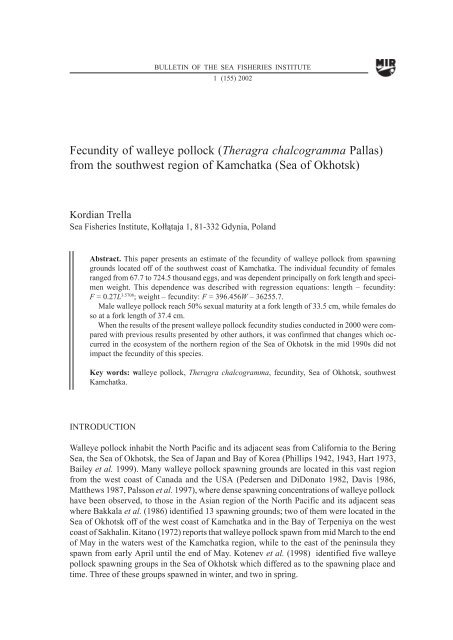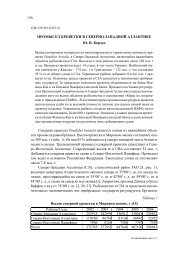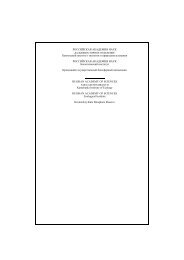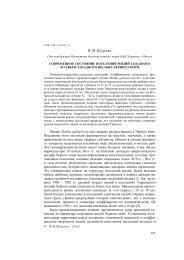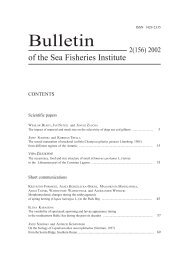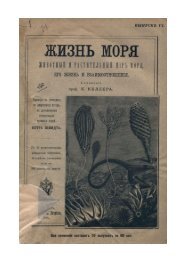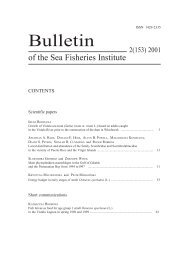Bulletin of the Sea Fisheries Institute 1 (155) 2002 - CEEMaR
Bulletin of the Sea Fisheries Institute 1 (155) 2002 - CEEMaR
Bulletin of the Sea Fisheries Institute 1 (155) 2002 - CEEMaR
Create successful ePaper yourself
Turn your PDF publications into a flip-book with our unique Google optimized e-Paper software.
BULLETIN OF THE SEA FISHERIES INSTITUTE<br />
1 (<strong>155</strong>) <strong>2002</strong><br />
Fecundity <strong>of</strong> walleye pollock (Theragra chalcogramma Pallas)<br />
from <strong>the</strong> southwest region <strong>of</strong> Kamchatka (<strong>Sea</strong> <strong>of</strong> Okhotsk)<br />
Kordian Trella<br />
<strong>Sea</strong> <strong>Fisheries</strong> <strong>Institute</strong>, Ko³³¹taja 1, 81-332 Gdynia, Poland<br />
Abstract. This paper presents an estimate <strong>of</strong> <strong>the</strong> fecundity <strong>of</strong> walleye pollock from spawning<br />
grounds located <strong>of</strong>f <strong>of</strong> <strong>the</strong> southwest coast <strong>of</strong> Kamchatka. The individual fecundity <strong>of</strong> females<br />
ranged from 67.7 to 724.5 thousand eggs, and was dependent principally on fork length and specimen<br />
weight. This dependence was described with regression equations: length – fecundity:<br />
F = 0.27L 3.5708 ; weight – fecundity: F = 396.456W – 36255.7.<br />
Male walleye pollock reach 50% sexual maturity at a fork length <strong>of</strong> 33.5 cm, while females do<br />
so at a fork length <strong>of</strong> 37.4 cm.<br />
When <strong>the</strong> results <strong>of</strong> <strong>the</strong> present walleye pollock fecundity studies conducted in 2000 were compared<br />
with previous results presented by o<strong>the</strong>r authors, it was confirmed that changes which occurred<br />
in <strong>the</strong> ecosystem <strong>of</strong> <strong>the</strong> nor<strong>the</strong>rn region <strong>of</strong> <strong>the</strong> <strong>Sea</strong> <strong>of</strong> Okhotsk in <strong>the</strong> mid 1990s did not<br />
impact <strong>the</strong> fecundity <strong>of</strong> this species.<br />
Key words: walleye pollock, Theragra chalcogramma, fecundity, <strong>Sea</strong> <strong>of</strong> Okhotsk, southwest<br />
Kamchatka.<br />
INTRODUCTION<br />
Walleye pollock inhabit <strong>the</strong> North Pacific and its adjacent seas from California to <strong>the</strong> Bering<br />
<strong>Sea</strong>, <strong>the</strong> <strong>Sea</strong> <strong>of</strong> Okhotsk, <strong>the</strong> <strong>Sea</strong> <strong>of</strong> Japan and Bay <strong>of</strong> Korea (Phillips 1942, 1943, Hart 1973,<br />
Bailey et al. 1999). Many walleye pollock spawning grounds are located in this vast region<br />
from <strong>the</strong> west coast <strong>of</strong> Canada and <strong>the</strong> USA (Pedersen and DiDonato 1982, Davis 1986,<br />
Mat<strong>the</strong>ws 1987, Palsson et al. 1997), where dense spawning concentrations <strong>of</strong> walleye pollock<br />
have been observed, to those in <strong>the</strong> Asian region <strong>of</strong> <strong>the</strong> North Pacific and its adjacent seas<br />
where Bakkala et al. (1986) identified 13 spawning grounds; two <strong>of</strong> <strong>the</strong>m were located in <strong>the</strong><br />
<strong>Sea</strong> <strong>of</strong> Okhotsk <strong>of</strong>f <strong>of</strong> <strong>the</strong> west coast <strong>of</strong> Kamchatka and in <strong>the</strong> Bay <strong>of</strong> Terpeniya on <strong>the</strong> west<br />
coast <strong>of</strong> Sakhalin. Kitano (1972) reports that walleye pollock spawn from mid March to <strong>the</strong> end<br />
<strong>of</strong> May in <strong>the</strong> waters west <strong>of</strong> <strong>the</strong> Kamchatka region, while to <strong>the</strong> east <strong>of</strong> <strong>the</strong> peninsula <strong>the</strong>y<br />
spawn from early April until <strong>the</strong> end <strong>of</strong> May. Kotenev et al. (1998) identified five walleye<br />
pollock spawning groups in <strong>the</strong> <strong>Sea</strong> <strong>of</strong> Okhotsk which differed as to <strong>the</strong> spawning place and<br />
time. Three <strong>of</strong> <strong>the</strong>se groups spawned in winter, and two in spring.


